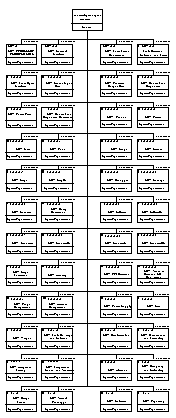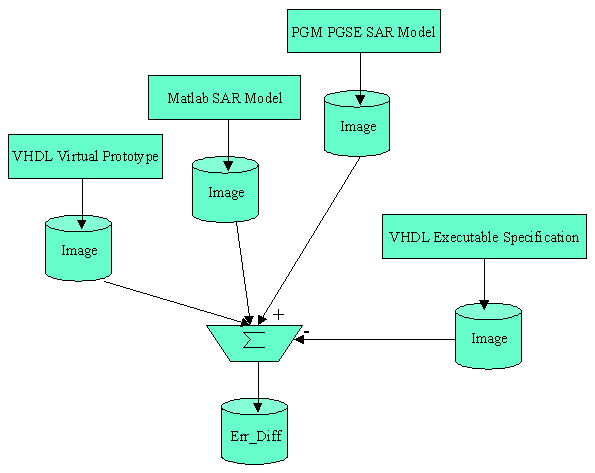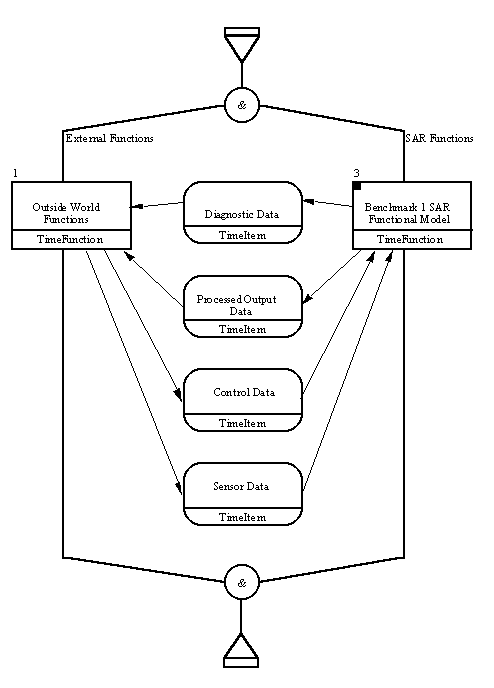Next: 4 Architecture Design Up: Case Studies Index Previous:2.0 Overview of the Problem with the Synthetic Aperture Array System
![]()
![]()
![]()
![]()
Next: 4 Architecture Design
Up: Case Studies Index
Previous:2.0 Overview of the
Problem with the Synthetic Aperture Array
System
The first step captured the requirements in the form of simulatable functions, or "executable
specification." An Executable Specification is a description of a system or subsystem that can be executed in a computer simulation, the purpose of which is to reflect the precise behavior of the intended system. All functions were independent of implementation at the level of the Executable Specification. MIT/Lincoln Laboratory (MIT/LL) generated the
Executable Specification for the synthetic aperture radar (SAR) processor and delivered it to
Lockheed Martin Advanced Technology Laboratories (LM ATL) as part of the SAR's processor requirements.
Virtual prototyping played a major role at each level of the top-down design process.
Prototyping began at an abstract level and proceeded to more concrete descriptions as
details resolved. Models supported the process at each level of abstraction to verify distinct
aspects of the system and its components. The resulting hierarchical model set would
support model-year upgrades by providing various degrees of
implementation-independent description of the system's functionality.
Virtual prototyping began with an Executable Specification that described the system's
signal-processing requirements. Refinement of this specification was a joint effort among contractor and customer to obtain a top-level design guideline that captured the customer's needs. The Executable Specification removed ambiguity associated with written specifications. Token-based performance-model virtual prototyping determined resource requirements like number of processors and memory requirements.
Developers evaluated the impact of different mappings of software functions to processing
hardware. At the next level, an abstract, behavioral, virtual prototype verified the
correctness and performance of the signal-processor design. At the lowest design
level, a detailed behavioral virtual prototype described clock-cycle and bit-level
details of the new hardware. All virtual-prototype models verified hardware/software
interaction. Table 3- 1 summarizes the purposes of the primary virtual prototype
models.
The system engineering tools were not integrated during the SAR benchmark instead the
tools were used individually. The SAR results and templates were used as examples to
drive the tool integration and define the data exchange necessary for systems trade-off
studies. See the RASSP System Process application note for more information on the
RASSP system design process and the use of the Integrated System Engineering tools, ISE
( Figure 3 - 2).
Requirement names are in the center of each requirement block. Each requirement name has
a prefix that indicates the origin or the level of the requirement. An example is requirement
3.1.1.1. Its name has the prefix SOW that indicates it originated in the BTD but that
it may contain minor re-wording. A lesson learned was that all originating
requirements must be kept in original form within the database. The CIDS requirements
must be separate entries in the database with traceability to the BTD requirements.
In the requirements diagram, all requirements with a black square in the upper left corner
have further decomposition and allocations that can be retrieved by clicking on that
requirement. In a more complex system, the whole process would be repeated at each
subsystem level.
After generating the CIDS, developers performed Requirements Analysis in parallel with
Functional Analysis and System Partitioning tasks. An example is requirement 3.2.1.2.2
SOW PRI Detection. Clicking on that requirement in Figure 3 - 3 displays the full
decomposition, derivation, and allocation of the originating requirement. Decomposition
refers to
the action of separating multiple requirements into individual requirements. During
decomposition, the form of the requirement does not change and only minor
re-wordings or budgeting are permitted. Derivation of a requirement changes the basic
form of the requirement to make it appropriate for a lower level subsystem. An example is a
noise budget that can be decomposed into individual subsystem noise contributions, but it
might
be derived to word width
and linearity for an A/D (analog to digital) converter.
The first step was to decompose paragraphs into individual requirements or requirement
sets. A requirement set was a cluster of requirements that could be allocated to a single
function and system element. In addition, a proper requirement set had to be verifiable
through a single test, inspection, demonstration, or analysis. In this case, the original
requirement paragraph (3.2.1.2.2) was decomposed into six different requirement sets.
The requirement number and SOW prefix now contain a letter suffix (3.2.1.2.2.a) to
indicate that the requirement is a decomposition of the originating requirement.
The system then traced requirement 3.2.1.2.2a to the function Get Sensor Data,
which was the functionality mandated by the requirement. Get Sensor Data was
then allocated to the Data I/O Module. Once the subsystem was assumed (i.e., Data I/O
Module), a specification had to be generated for that subsystem. The requirements in the
Data I/O Module specification have to be traced to the originating requirements. In this
case, the Data I/O Module requirement DATA Data Synchronization was either a
derivation or decomposition of requirement 3.2.1.2.2.a. The DATA prefix was placed on
the equipment name to indicate that this was a requirement from the Data I/O Module
specification.
After the initial partitioning and functional allocation was completed, the Subsystems Architecture and Allocations Document [sar_all.pdf] was generated from the database. The following full set of software and hardware development specifications were generated automatically from the RDD- 100 database:
Generating all specifications from this database minimized discrepancies among
documents. The database also defined hardware/software and hardware/hardware interfaces. The Interface Definition Specification [sar-ids.pdf] was automatically generated from the database.
The Executable Specification model included information on I/O (input/output) timing
constraints, I/O protocols, I/O data formats, system latency, and internal function. The
external ports were modeled with clock-cycle temporal precision and bit-true data
values. By design, the Executable Specification did not contain information on hardware
implementation or structure, except where compatibility with external interfaces required it.
This allowed maximum flexibility in architecture selection and detailed design. The internal
function did not contain timing, except for input- to-output latency. Data was
expressed as floating point values.
The purpose of the Executable Specification was to detail processor requirements and to
provide a fully functional test bench to verify more detailed VHDL-structural models
of the SAR processor. Output images from the Executable Specification simulations were
compared with outputs from functional simulations [VHDL virtual prototype (abstract and
detailed behavioral), matlab simulations, and Processing Graph Method (PGM) Processing
Graph Support Environment (PGSE) simulations] to determine the maximum pixel error
difference (Figure 3- 4).
The processor model and test bench consists of about 2400 lines of VHDL code, and
MIT/LL reported that the Executable Specification took about 1300 hours to develop. Some
of this effort was attributable to first-time learning. Find more information on the
Executable Specification in the following:
The Executable Specification took 142 minutes on a Sparc - 10 to process one frame
of
data for one polarization, and it required a minimum swap space of 256 MB for efficient
execution. The large amount of time was a consequence of using VHDL signals to model
bit-level transfers at the interface between the SAR processor and the test bench.
Although some experts believe a functional analysis can be independent of the system
partitioning, the SAR
Benchmark developers believe it to be impractical because each low-level function has
to be allocable to only one
subsystem and verifiable by a single test, demonstration, inspection, or analysis. In
addition, some required
functionality, such as subsystem-to-subsystem interfaces, may exist only because
of the implementation. Ignoring
this additional required functionality during a functional analysis can compromise the
system-partitioning activity by
ignoring its impacts on hardware loading and software timelines.
The functional decomposition of the SAR began with a simple behavior diagram that
showed the SAR function, the outside world, and the data that was exchanged among these
two functions. Figure 3- 5 shows the top-level behavior diagram generated from
the RDD- 100 database. (See RDD- 100 Behavior Diagram Notation Tutorial.)
This figure indicates that there are two major input-data types and two major
data-output types. The SAR processor received control information and sensor data,
sent diagnostic data, and processed output data to the outside world. It was not
important for the design to know how the data was created or used in the outside world
because the interface was well defined in the BTD.
Following the top level view as shown in Figure 3- 5, further decompositions were
performed to show explicit functionality and then to add implicit functionality. The original
functional decomposition was based solely on the requirements and it proved to be
un-allocable. When allocations were performed, each hardware/software element
appeared to perform disjoint functions, instead of highly inter-related functions. As a
result, the functional decomposition may have provided information on the SAR as a whole
but it was useless at providing an understanding of the individual hardware and software
elements. An updated functional decomposition was generated as a result of the system
partitioning. The functions were used as the basis for the final allocation of the functional
requirements to the hardware and software elements.
The final functional description in Figure 3- 5 is hierarchical and explorable. As in the
requirements diagram, clicking any element with a box in the upper left corner will show
additional decomposition. Click on the box
Benchmark 1 SAR Functional Model to view first-level decomposition. This level
was derived primarily from
the hardware/software partitioning. The top-level SAR functions are the following:
The Processor Element Platform Functions and Host Interface Platform
Functions were added during
the functional analysis because they were necessary sources and sinks of some Control and
Configuration Function
data items. These were simple additions but they could have become complex, depending
on the system's
complexity and the completeness of system-level requirements.
At lower levels there was also required functionality that was not explicitly called for in the
BTD or CIDS. An example was the Build Command Line Function within the
Control and Configuration Function. Partitioning-specific details were present in the
functional decomposition but they were added in a way to minimize handicapping the
architecture-selection process.
By detailing functionality to lower levels, a better understanding was gained of the
requirements and the partitioning that was required to satisfy them. An example of this
were the Data Processing Functions (3.4) . Clicking on this box in the
first-level decomposition exposed the next level of detail. From this diagram, the
details of the
Range Processing and the Azimuth Compression Functions were seen by
clicking on either box. The behavior diagrams were taken to this detail to understand and
partition processing among the Data I/O Module and the COTS (commercial
off-the-shelf) signal processors. The final allocation showed FIR ( Finite Impulse
Response) filtering being done in custom hardware, and the range and azimuth processing
being done in the COTS
hardware.
The system partitioning done as part of the engineering process was preliminary. On the
SAR benchmark, Candidate
2 was selected during architecture selection. The SHARC module was unavailable. The
cost and reliability impacts
were instantly available because of the simplicity of RASSP's ISE tools.
3 System Design
3.1 System Process Description
The system process captured customer requirements and converted them into functional and
performance processing requirements (Figure 3- 1). Signal processor developers then
performed functional and performance analyses to properly decompose the
system-level description.

3.1.1 RASSP Innovations in the System Design
Process
3.1.1.1 Hierarchical Simulation
The verification methodology of the Rapid Prototyping of
Application-Specific Signal Processors (RASSP) process
deviated significantly from the traditional approach of physical prototyping. The RASSP
methodology uses a top- down VHSIC Hardware Design
Language (VHDL) -based, hierarchical, virtual-prototyping process. This process
supported accurate trade-offs by using simulations to verify interaction of the
hardware/software. To the maximum extent possible, users chose models, largely
composed of hierarchical VHDL models of the architecture, from the
model-year architecture elements in RASSP's reuse library, Users developed new
library elements and inserted them into the reuse library as required.
Model
Purpose
Entity
Resolution
Signal
Resolution
Time
Resolution
Executable
Specification
Accurately describe
function and system interface
requirements
System and
interfaces
Abstract
values
Major
event
Performance
Model
Optimize mapping,
verify throughput, check
resource requirements
Functional
units (Processing
element, switch,
memory)
Abstract
tokens
Major
event
Abstract
Behavior
Test numerical
correctness, generate test
point data, verify overall
approach
Functional
units (Processing
element, switch,
memory)
Abstract
values
Major event
Detailed
Behavior
Verify design and
system interaction
IC, MCM,
descretes
Bit-true
Clock edge
3.1.1.2 System Tools
Developers used Ascent Logic
Corporation's RDD- 100 tool to perform requirement analysis, functional
analysis, and physical decomposition for the SAR benchmark. RDD- 100 is an Entity,
Relationship, Attribute (ERA) database tool with a graphical user interface that provides
developers with requirement, functional, and physical views of the system. The
requirements are related to the functions and the functions are allocated to the physical
architecture. The interrelation of these three views enabled the systems engineers to
automatically generate the level specification documents from the RDD- 100 database.
The physical view let developers use PRICE's cost model and Management Sciences,
Inc.'s RAM-ILS tool to analyze cost, reliability, and maintainability.

3.2 System Requirements Analysis
MIT/LL provided
the originating
requirements for the SAR in a Benchmark Technical Description
(BTD) and Benchmark Executable Specification. The BTD contained programmatic
and system requirements. Developers extracted the systems requirements from this
document and placed them in the RDD- 100 database. The database then generated a
SAR Configuration Item Development Specification
(CIDS) based on these requirements. To achieve this, developers reworded, reordered, and
refined the BTD requirements in the database using the Benchmark Executable
Specification for clarification. They then performed in RDD- 100 requirements
analysis
and functional analysis based on the CIDS. As a result, they maintained traceability to the
BTD and they generated from the RDD- 100 database a full set of software and
hardware specifications. For more information, see the application note Integrated System Tools.
Figure 3 - 3 shows the SAR requirements tree. The source document at the top of the
tree is the BTD. Each block below the source is a requirement documented by the source.
In the upper left corner of each requirement block is the requirement number. If the
requirement number has an SOW (statement of work) prefix, then that requirement is a
BTD paragraph that does not contain a true requirement for the SAR. It may contain
descriptive or non-technical programmatic information. Developers incorporated these
types of paragraphs into the CIDS. An example is requirement SOW.2.2, External
Interfaces, which is in the upper left corner. It was only a title paragraph with actual
requirements located in subparagraphs. The requirements that have no prefix on the
associated requirement number, such as 3.1.1.1, are CIDS requirements.

3.2.1 Executable Specification
The MIT/LL also provided an Executable Specification and written requirements. The
Executable Specification package included a SAR processor model, test bench, input
stimuli of two four-frame input data sets, reference images, and a user's manual.

3.3 Functional Analysis
After completing the initial requirement decomposition, developers started a functional
analysis. Functional analysis is decomposing a system into individual actions it must
perform, where each action is called a function. Functional analysis must include a
description of those actions or functions and the implicit and explicit flow of control and
data associated with that functionality. Developers performed the SAR functional analysis
in conjunction with systems partitioning and continued requirement analysis. The result of
the functional analysis process was a description of the functional requirements as a set of
verifiable and allocable functions and the interaction of
those functions. The prime
purpose of performing this analysis was to ensure that all implied and
partitioning-specific functionalities were fully
understood.

* Mean Time Between Component Failure 3.5 Lessons Learned in System Design
3.5.1 Executable Specification
Lessons learned from using the Executable Specification were the following:

3.5.2 System Tools
The developers had not previously used PRICE's cost tools, so a member of the
development team spent
several weeks ensuring that the cost estimates were accurate within 10 percent of
bottom-up calculations. This
estimate was provided in less than a day or in about 20 percent of the time needed for a
full bottom-up calculation.
The lessons learned from the SAR Benchmark using the system tools were the following:
![]()
![]()
![]()
![]()
Next: 4 Architecture Design
Up: Case Studies Index
Previous:2.0 Overview of the
Problem with the Synthetic Aperture Array
System